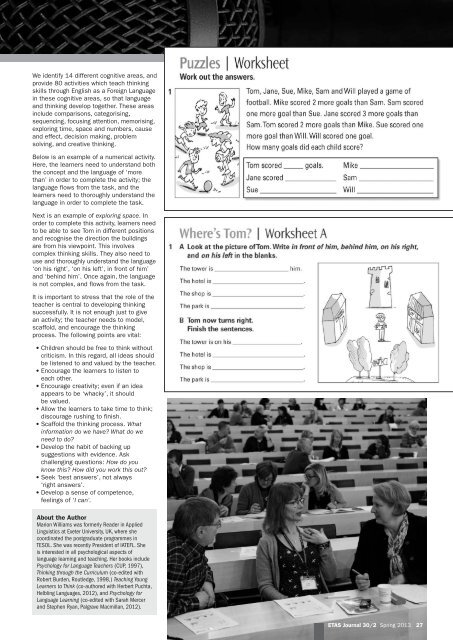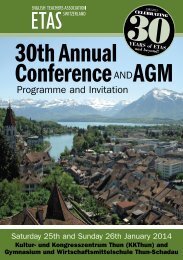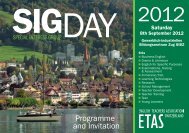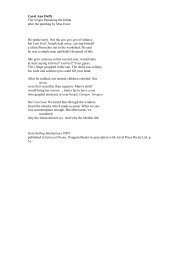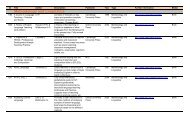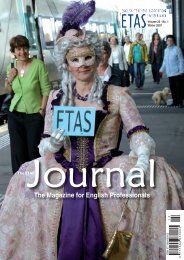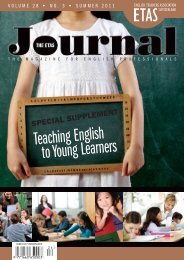ETAS 29th AGM and Convention SupplementPlenariesDevelopment (CPD), observations andfeedback, parents meetings, and so on,and should be conspicuously connected toschool-wide learning.Here are seven tips for teachers that couldhelp make systems visible, and which couldprovide a starter for the learning mantra:1. Check out the other perspectives inthe room2. Get real. Stop wishing your studentswere different from how they are3. Look for unintended consequences inall your classroom actions4. Bother less about trying to control,and encourage connectivity5. Start conversations about whatevermatters to whoever is there6. See the whole school as an adventurepark for your learning7. Make lesson plans but don’t expectthem to work outNew leadershipNow let’s turn briefly to the issue <strong>of</strong> thekind <strong>of</strong> leadership needed to allow any <strong>of</strong>the ideas in this article to take root in anorganisation. When you look at socialstructures through history, you can’t failto notice the human tendency towardshierarchical organisation: putting anall-knowing, all-wise, all-powerful leader atthe top, sometimes referred to as heroicleadership. But this familiar style <strong>of</strong>leadership is changing. The traditional,hierarchical top-down approach is workingless and less well in settings wherecomplexity is increasing. It is not smartenough for today’s complexity, where youneed leadership dispersed throughout thesystem. Some <strong>of</strong> the particular challengesto heroic leadership are:• Control does not seem to work witha Mess. What is needed is connectivity.Single location heroic leadership is notgood at this.• Decisions today are based on uncertainand insufficient data, and cause andeffect are <strong>of</strong>ten separated in time andplace and hard to learn from.• There is the increasingly voiced demandthat leadership serves people, notjust itself.• There is the demand that work andeducation should have personalsignificance and ‘worthwhileness’.People want to take values to work,not sacrifice them in order to work.• Leaders need to have self-knowledgeand personal maturity if they are totackle any <strong>of</strong> the above, in order to seethe problems as they are.These factors draw forth a different kind <strong>of</strong>leadership. Here are three characteristics <strong>of</strong>the newly emerging paradigm <strong>of</strong> leadership:1. Who is a leader? There is a shift infocus from leader to leadership, fromthe person <strong>of</strong> the leader to the activity<strong>of</strong> leadership. By unhooking leadershipfrom position, we see that it can comefrom anywhere in a system. Teacher,26 ETAS <strong>Journal</strong> 30/2 <strong>Spring</strong> <strong>2013</strong>head teacher, parent, or pupil,leadership is the activity <strong>of</strong> oneperson wanting to get something donethrough other people.2. The focus <strong>of</strong> leadership action: thisshifts away from the old notion <strong>of</strong>influencing the community to follow theleader’s vision, and towards the idea<strong>of</strong> influencing the community to faceits problems (Heifetz, 1994).3. What holds it all together? Coercion orpurpose? This idea is well expressedby Roger Lewin: “When people arealigned to their purpose, when the gapbetween values and behaviours closes,what people experience is a stream <strong>of</strong>ease…” (2001). So when personalmeaning and action stack up, energyflows and connection grows. Sharedpurpose begins to develop and to holdthings together. In the absence <strong>of</strong>shared purpose, one person’s purposegets imposed on others, and youhave to rely on coercion to holdthings together.ConclusionTo conclude then, according to a systemicview, a healthy school and its leadershipstrive to distinguish mess from difficulty,refrain from trying to solve the former, butmeet it with connectivity rather than control,install connected-up learning as part <strong>of</strong> theoperating system, and encourage systemicthinking and participation in leadershipactivity, which in turn is dispersedthroughout the system.The message in a nutshell? Embracingmess, learning, and leadership are threesides <strong>of</strong> the same coin.ReferencesAck<strong>of</strong>f, R. (1974). Redesigning the future: A systemsapproach to societal problems. New York, NY: JohnWiley & Sons, Inc.Ack<strong>of</strong>f, R. (1999). Ack<strong>of</strong>f’s best: His classic writings onmanagement. New York, NY: John Wiley & Sons, Inc.Heifetz, R. (1994). Leadership without easy answers.Cambridge, MA: Harvard University Press.Lewin, R., & Regine, B. (2001). Weaving complexity andbusiness: Engaging the soul at work. New York, NY:Texere Publishing.Pedler, M., & Aspinwall, K. (1998). Concise guide to thelearning organization. London, UK: Lemos & Crane.Schön, D. (1983). The reflective practitioner. New York,NY: Basic Books, Inc.About the AuthorAdrian Underhill is a freelance consultant helpingschools to develop their organisational intelligence,and trainer <strong>of</strong>fering programmes on facilitation andleadership. He is a past president <strong>of</strong> IATEFL. Hisinterests include applications <strong>of</strong> complexity thinkingto leadership and teaching and the use <strong>of</strong> actioninquiry in pr<strong>of</strong>essional learning. He is series editor<strong>of</strong> Macmillan Books for <strong>Teachers</strong> (2009), andauthor <strong>of</strong> Sound Foundations: Learning andTeaching Pronunciation (Macmillan Education,2005). He has just brought out an iPhone/androidapp: SOUNDS: The Pronunciation App. A currentinterest is the role <strong>of</strong> skilful improvisationin teaching.PLENARYDeveloping thinkingin young learnersM A R I O N W I L L I A M SWhen children leave school, and indeedbefore, they will need to face the challenges<strong>of</strong> a changing and unpredictable world.They will need a range <strong>of</strong> decision-makingand problem-solving strategies in order t<strong>of</strong>ace unexpected problems that will arisein the future and tackle them competently.However, many school curricula do notfoster this ability. Instead they tend to bebased on systematic, error-free learning,correct answers, assimilation <strong>of</strong> facts, andassessment by teachers. Life, however,is not full <strong>of</strong> correct answers; we generallyneed to find the best answer for aparticular problem in a particular situation.And in life, learning is not neatly packagedin small, systematic steps; it is far morecomplex than this. It is thereforeimportant to prepare our learners to facenovel and unpredictable challenges, andfind ways <strong>of</strong> solving unforeseen problemswith confidence.The growing literature in the field <strong>of</strong>teaching thinking shows that thinking canbe taught, and that success in thisventure is largely due to good teaching.An excellent review <strong>of</strong> the literature inthis area can be found on the websitehttp://www.thinkingschool.co.uk/The thinking movement is expandinginternationally, and the number <strong>of</strong>programmes on the market is growing.These are described on the website above.Notable are Reuven Feuerstein’sInstrumental Enrichment Program, Blagg etal.’s Somerset Thinking Skills Course,Matthew Lipman’s Philosophy for Children,and David Hyerle’s Thinking Maps. NigelBlagg and his associates provide a clear“problem solving cycle” <strong>of</strong> six stageswhich involve looking carefully at all theinformation provided, defining the problem,generating approaches to solving it, takingaction, monitoring progress, andcommunicating solutions.In our recent book, Teaching Young Learnersto Think (Helbling Languages, 2012),Herbert Puchta and I provide a theoreticalunderpinning to the teaching <strong>of</strong> thinking.
We identify 14 different cognitive areas, andprovide 80 activities which teach thinkingskills through <strong>English</strong> as a Foreign Languagein these cognitive areas, so that languageand thinking develop together. These areasinclude comparisons, categorising,sequencing, focusing attention, memorising,exploring time, space and numbers, causeand effect, decision making, problemsolving, and creative thinking.Below is an example <strong>of</strong> a numerical activity.Here, the learners need to understand boththe concept and the language <strong>of</strong> ‘morethan’ in order to complete the activity; thelanguage flows from the task, and thelearners need to thoroughly understand thelanguage in order to complete the task.Next is an example <strong>of</strong> exploring space. Inorder to complete this activity, learners needto be able to see Tom in different positionsand recognise the direction the buildingsare from his viewpoint. This involvescomplex thinking skills. They also need touse and thoroughly understand the language‘on his right’, ‘on his left’, in front <strong>of</strong> him’and ‘behind him’. Once again, the languageis not complex, and flows from the task.It is important to stress that the role <strong>of</strong> theteacher is central to developing thinkingsuccessfully. It is not enough just to givean activity; the teacher needs to model,scaffold, and encourage the thinkingprocess. The following points are vital:• Children should be free to think withoutcriticism. In this regard, all ideas shouldbe listened to and valued by the teacher.• Encourage the learners to listen toeach other.• Encourage creativity; even if an ideaappears to be ‘whacky’, it shouldbe valued.• Allow the learners to take time to think;discourage rushing to finish.• Scaffold the thinking process. Whatinformation do we have? What do weneed to do?• Develop the habit <strong>of</strong> backing upsuggestions with evidence. Askchallenging questions: How do youknow this? How did you work this out?• Seek ‘best answers’, not always‘right answers’.• Develop a sense <strong>of</strong> competence,feelings <strong>of</strong> ‘I can’.About the AuthorMarion Williams was formerly Reader in AppliedLinguistics at Exeter University, UK, where shecoordinated the postgraduate programmes inTESOL. She was recently President <strong>of</strong> IATEFL. Sheis interested in all psychological aspects <strong>of</strong>language learning and teaching. Her books includePsychology for Language <strong>Teachers</strong> (CUP, 1997),Thinking through the Curriculum (co-edited withRobert Burden, Routledge, 1998,) Teaching YoungLearners to Think (co-authored with Herbert Puchta,Helbling Languages, 2012), and Psychology forLanguage Learning (co-edited with Sarah Mercerand Stephen Ryan, Palgrave Macmillan, 2012).ETAS <strong>Journal</strong> 30/2 <strong>Spring</strong> <strong>2013</strong> 27


